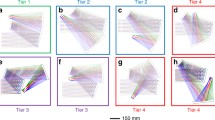Abstract
In this paper, the study of projection properties of two-level factorials in view of geometry is reported. The concept of uniformity pattern is defined. Based on this new concept, criteria of uniformity resolution and minimum projection uniformity are proposed for comparing two-level factorials. Relationship between minimum projection uniformity and other criteria such as minimum aberration, generalized minimum aberration and orthogonality is made explict. This close relationship raises the hope of improving the connection between uniform design theory and factorial design theory. Our results provide a justification of orthogonality, minimum aberration, and generalized minimum aberration from a natural geometrical interpretation.
Similar content being viewed by others
References
Box, G. E. P., Hunter, W. G., Hunter, J. S., Statistics for Experimenters, New York: Wiley, 1978.
Fries, A., Hunter, W. G., Minimum aberration 2 k?p designs, Technometrics, 1980, 22(4): 601–608.
Tang, B., Deng, L. Y., Minimum G2-aberration for nonregular fractional designs, Ann. Statist., 1999, 27(6): 1914–1926.
Ma, C. X., Fang, K. T., A note on generalized aberration factorial designs, Metrika, 2001, 53(1): 85–93.
Xu, H., Wu, C. F. J., Generalized minimum aberration for asymmetrical fractional factorial designs, Ann. Statist., 2001, 29(2): 549–560.
Lin, D. K. J., Draper, N. R., Projection properties of Plackett and Burman designs, Technometrics, 1992, 34(3): 423–428.
Lin, D. K. J., Draper, N. R., Generating alias relationship for two-level Plackett and Burman designs, Computational Statistics and Data Analysis, 1993, 15(1): 147–157.
Box, G. E. P., Bisgaard, S., What can you find out from 12 experimental runs? Quality Engineering, 1993, 5: 663–668.
Wang, J. C., Wu, C. F. J., A hidden projection property of Plackett-Burman and related designs, Statistica Sinica, 1995, 5(1): 235–250.
Cheng, C. S., Some projection properties of orthogonal arrays, Ann. Statist., 1995, 23(4): 1223–1233.
Cheng, C. S., Projectivity and resolving power, Journal of Combinatorics, Information & System Sciences, 1998, 23(1): 47–58.
Box, G. E. P., Tyssedal, J., Projective properties of certain orthogonal arrays, Biometrika, 1996, 83(4): 950–955.
Chen, H., Some projective properties of fractional factorial designs, Statist. Prob. Lett., 1998, 40(2): 185–188.
Deng, L. Y., Tang, B., Generalized resolution and minimum aberration criteria for Plackett-Burman and other nonregular factorial designs, Statist Sinica, 1999, 9(4): 1071–1082.
Deng, L. Y., Tang, B., Design selection and classification for Hadamard matrices using generalized minimum aberration criteria, Technometrics, 2002, 44(2): 173–184.
Tang, B., Theory of J-characteristics for fractional factorial designs and projection justification of minimum G2-aberration, Biometrika, 2001, 88(2): 401–407.
Wang, Y., Fang, K. T., A note on uniform distribution and experimental design, Chin. Sci. Bull., 1981, 26(3): 485–489.
Fang, K. T., Wang, Y., Number-Theoretic Methods in Statistics, London: Chapmanand Hall, 1994.
Fang, K. T., Lin, D. K. J., Winker, P. et al., Uniform design: Theory and applications, Technometrics, 2000, 42(3): 237–248.
Hickernell, F. J., A generalized discrepancy and quadrature error bound, Math. Comp., 1998, 67(221): 299–322.
Ma, C. X., Fang, K. T., Lin, D. K. J., On isomorphism of factorial designs, J. Complexity, 2001, 17(1): 86–97.
Ma, C. X., Fang, K. T., Lin, D. K. J., A note on uniformity and orthogonality, J. Statist. Planning and Inference, 2003, 113(1): 323–334.
Fang, K. T., Ge, G. N., A sensitive algorithm for detecting the inequivalence of Hadamard matrices, Math. Computation, 2004, 73(246): 843–851.
Hickernell, F. J., Liu, M. Q., Uniform designs limit aliasing, Biometrika, 2002, 89(4): 893–904.
Liu, M. Q., Hickernell, F. J., E(s 2)-optimality and minimum discrepancy in 2-level supersaturated designs, Statist. Sinica, 2002, 12(3): 931–939.
Fang, K. T., Mukerjee, R., Connection between uniformity and aberration in regular fractions of two-level factorials, Biometrika, 2000, 87(1): 173–198.
Fang, K. T., Ma, C. X., Mukerjee, R., Uniformity in fractional factorials, in Monte Carlo and Quasi-Monte Carlo Methods in Scientific Computing (eds. Fang, K. T., Hickernell, F. J., Nieder-reiter, H.), Berlin: Springer, 2002, 232–241.
Fang, K. T., Some Applications of Quasi-Monte Carlo Methods in Statistics, in Monte Carlo and Quasi-Monte Carlo Methods in Scientific Computing (eds. Fang, K. T., Hickernell, F. J., Niederreiter, H.), Berlin: Springer, 2002, 10–26.
Fang, K. T., Lin, D. K. J., Uniform experimental designs and their applications in industry, in Handbook of Statistics (eds. Khattree, R., Rao, C. R.), Vol. 22, North-Holland: Elsevier, 131–170.
Cheng, C. S., Steinberg, D. M., Sun, D. X., Minimum aberration and model robustness for two-level fractional factorial designs, J. R. Statist. Soc. B, 1999, 61(1): 85–93.
Cheng, C. S., Deng, L. Y., Tang, B., Generalized minimum aberration and design efficiency for nonregular fractional factorial designs, Statist Sinica, 2002, 12(4): 991–1000.
Hickernell, F. J., Lattice rules: How well do they measure up? in Random and Quasi-Random Point Sets (eds. Hellekalek, P., Larcher, G.), Lecture Notes in Statistics, Vol. 138, New York: Springer, 1998, 109–166.
MacWilliams, F. J., Sloane, N. J. A., The Theory of Error-Correcting Codes, Amsterdam: North-Holland, 1977.
Author information
Authors and Affiliations
Corresponding authors
Rights and permissions
About this article
Cite this article
Fang, K., Qin, H. Uniformity pattern and related criteria for two-level factorials. Sci. China Ser. A-Math. 48, 1–11 (2005). https://doi.org/10.1360/03ys0155
Received:
Revised:
Issue Date:
DOI: https://doi.org/10.1360/03ys0155




